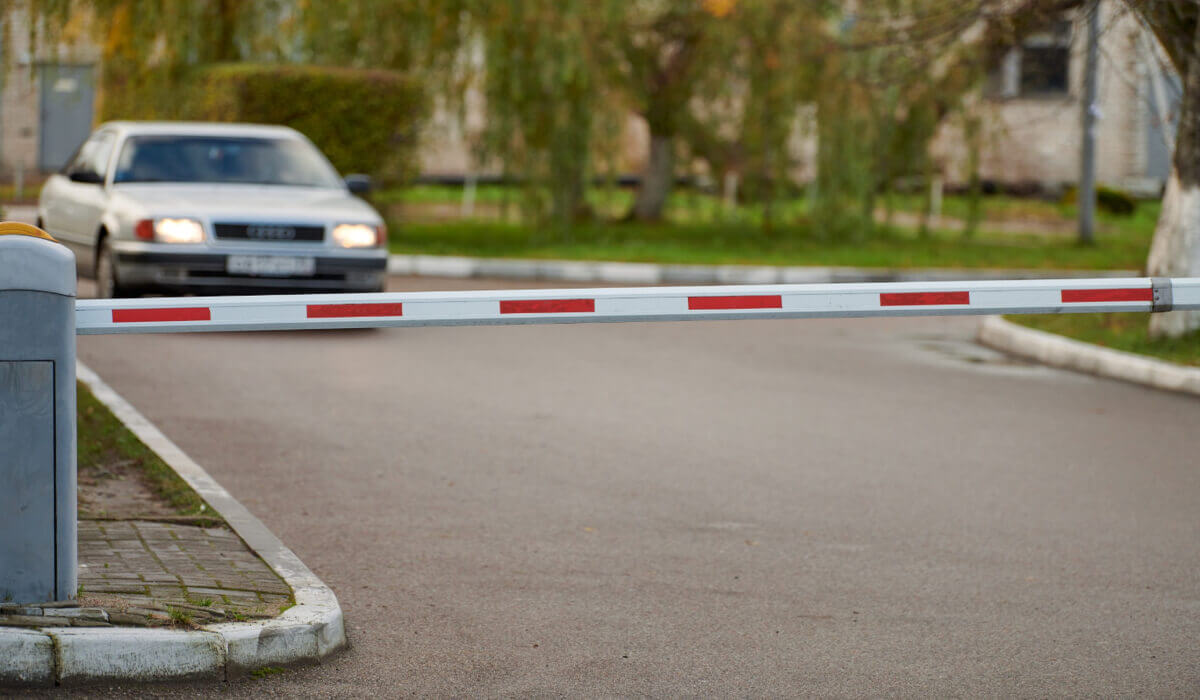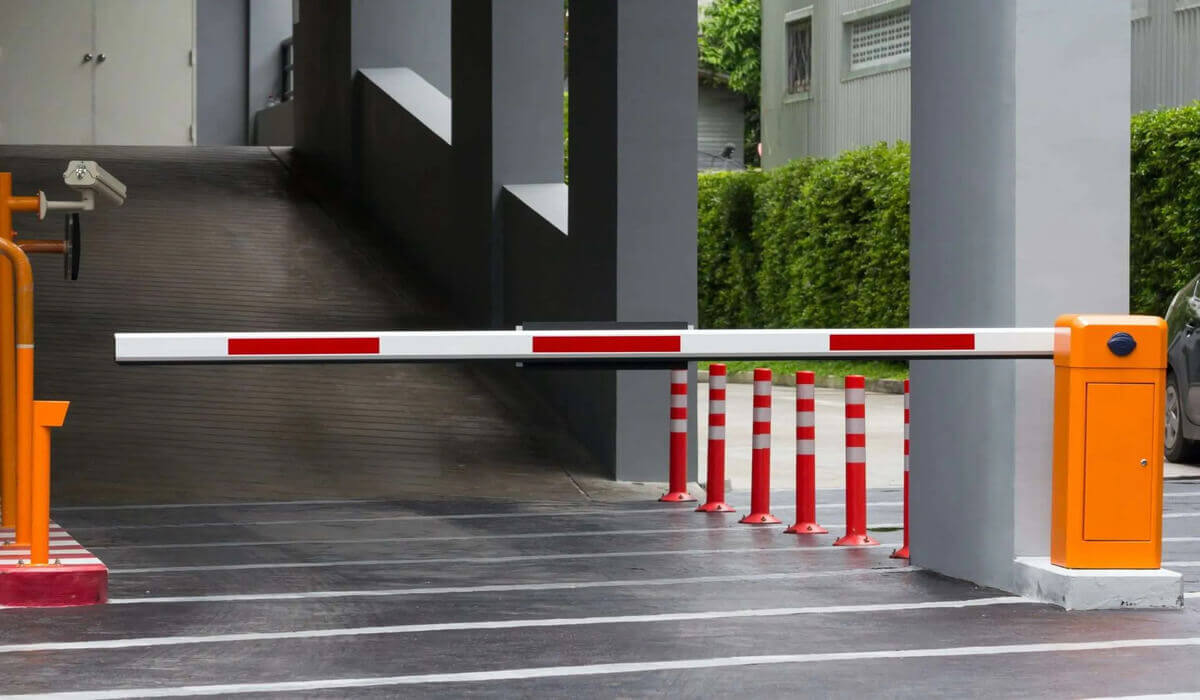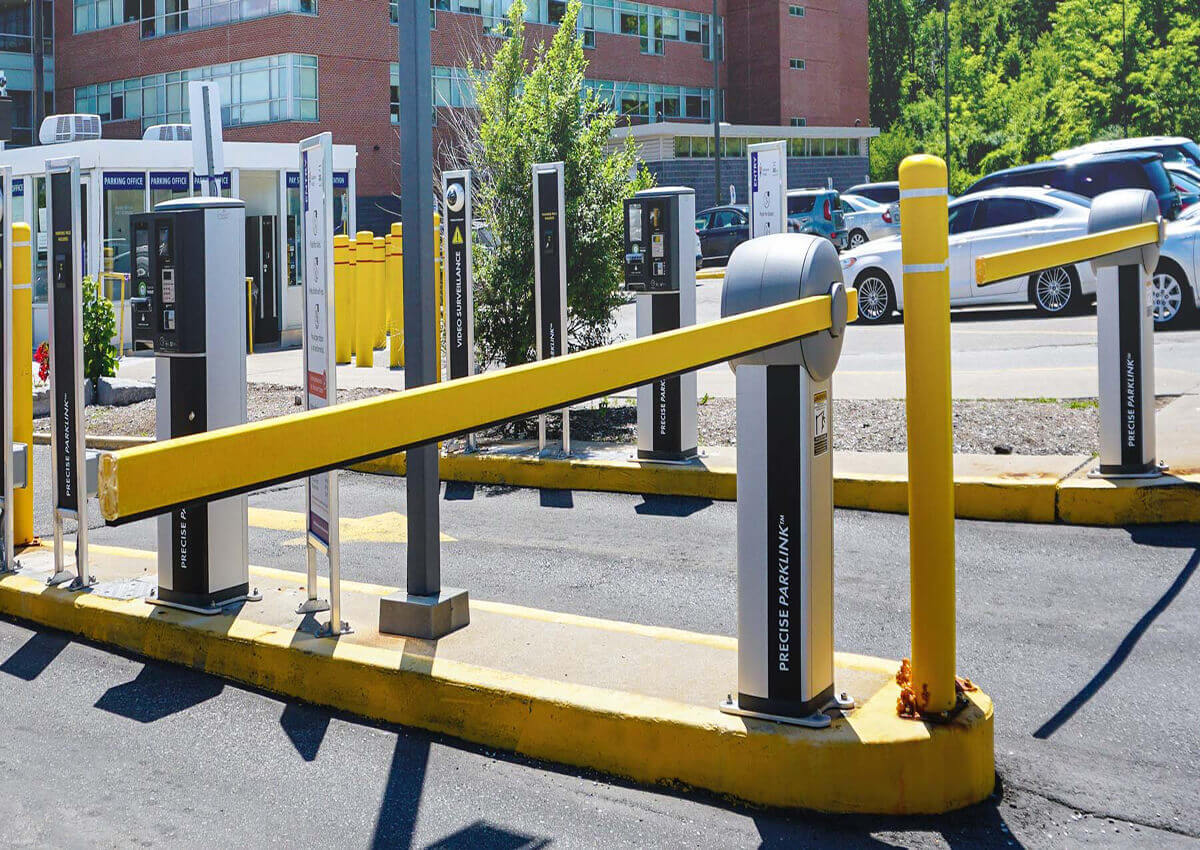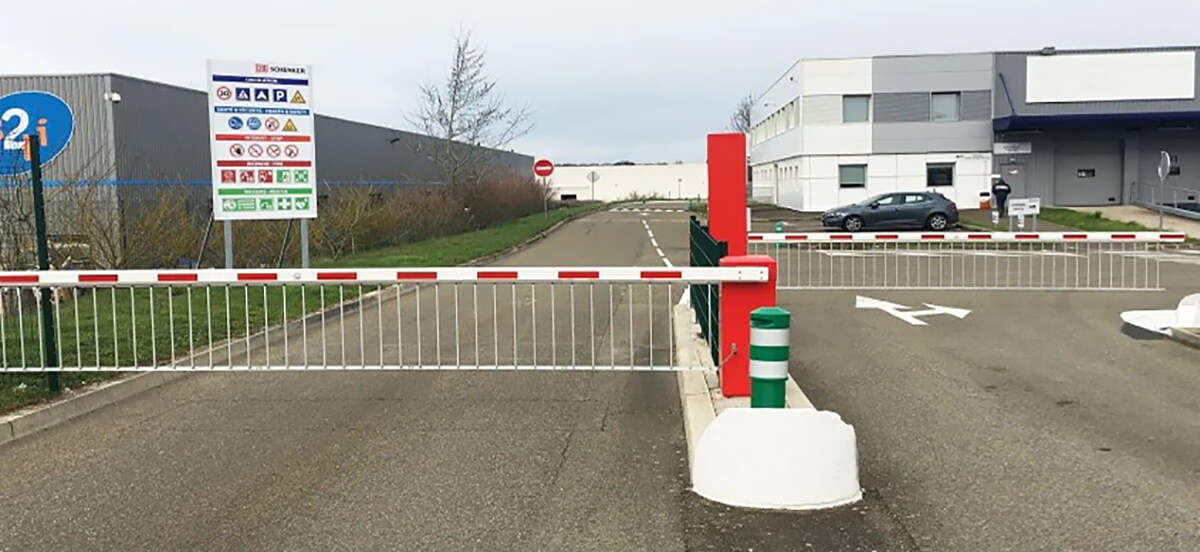In today’s guide, we will introduce parking barriers from the definition, components, types, and other aspects. Please read on to learn more.
1. What is a parking barrier?
Parking barriers are the most basic but most efficient automatic gates in use today, often referred to as automatic fences or vehicle access gates. Consists of a long arm that can descend automatically to block the passage of approaching vehicles. Vehicle drivers must first present their pass, enter a code, pay a toll, or wait for identification before they can lift the gate arm. The arm is usually raised and lowered by an electric motor, which is controlled by a sensor or security access system.

2. Components of parking barrier
Generally, a Parking Barrier consists of two parts: a gate column and a fence pole, one end of the gate can be rotated on the gate column, the other end is unsupported, and a fence pole receiving device is arranged on the gate column, which can be rotated around the horizontal axis for the arrangement of the guardrail fence. The utility model also includes a motor drive for a guardrail fence and a control system compatible with the motor drive.
The parking lane gate control system includes a gate rod absolute position detection and measurement device and a comparison circuit, which is characterized in that the absolute position detection and measurement device includes a gyroscope sensor. The characteristic of the control system is that the measuring device for position detection is arranged on the guard rail receiver on the guard rail or the guard rail post. In addition, the control system is used to detect the tilt Angle between the guard rail and the effective direction of gravity, as well as the tilt Angle between the guard rail and the guardrail post.
Guardrail fences may pivot around a set horizontal axis guardrail column and may include a closed position to an open position and vice versa. Guardrail fences are in a closed position, usually horizontal. When in the open position, the guard rail is usually in a vertical position, that is, aligned in the direction of gravity.
To arrange the guard rail, the guard rail column acts as the guard rail support, and the guard rail can be rotated around the horizontal axis. When fully assembled, the hinges secure the guard rail to one side, one end. On the other end, the railing has no trained support, which means that there is no support for the cabinet, and the railing in the railing’s closed position is away from the structural support at the end of the post. The ends of the balustrades farthest from the posts may float more freely.
For proper rotation, the guard rail is powered by an electric motor. A safety clutch is provided, which is located on the output side of the gearbox, that is, connected downstream of the gearbox, between the gearbox and the guardrail fence bracket. The guardrail fence is moved between the vertical open position and the horizontal closed position by a motor drive, which is also used to keep the guardrail fence in a suspended horizontal closed position so that there is no interference.
The arrival of the end position of the railing, i.e., on the other hand, the arrival of the horizontal closed position and the vertical open position, is detected by the appropriate position sensors located on the motor shaft of the motor drive on the input side of the transmission, or the drive shaft railing bracket, i.e., the transmission on the channel side.
These signals are detected by position sensors and the measured values are sent to the control unit, which follows the motion sequence according to the realization of the desired final position (corresponding to the position of the motor driver).
The safety clutch is designed to ensure that due to the forces acting on the guard rail, large torque is transmitted to the motor drive to be guided. For example, this can be caused by obstacles created in the path of a guardrail fence. But also through acts of vandalism.

3. How does the parking barrier work?
With a simple padlock system and no additional parts, manual parking barriers are easy to understand. You simply turn it locked on or off. However, automated parking barriers are more complicated than that. Generally speaking, the Parking Barrier consists of a boom, a control unit, and a motor. The boom is the guardrail that prevents the vehicle from passing, the control unit is the main command center of the guardrail, and the motor is the power source that maintains all operations. Other processes for parking barriers are:
1) Detection
No matter what type of automated Parking Barrier you have, the first step is always detection. The barrier must know when the vehicle is approaching, otherwise, it will not have enough time to react. Some automated roadblocks use ultrasonic sensors and other detectors to observe approaching vehicles. There are even license plate recognition systems that use cameras to detect vehicles. The same sensors are used to allow the vehicle to pass safely and prevent the vehicle from shutting down while still under the barrier.
2) Human intervention
Other automated parking barriers still require some kind of human intervention. Someone can operate the control unit and press a button or enter a code to turn the barrier on or off. This is common in Parking Barriers that require a fee or registration to enter.
An intercom system can also be installed to remotely contact authorized personnel. This could mean that the system will notify staff via mobile phone that they can grant access to the vehicle no matter where they are.
3) Move
When detection or human intervention occurs, the obstacle will start to move. When the vehicle passes, the sensor detects that the boom will remain open. Some barriers have a bounce function, and if the barrier that is closing suddenly detects someone, it will immediately “bounce back” and open again. This prevents unnecessary injury or damage.
Parking Barrier lift railings usually use a magnetic ring detector, and when the car passes the magnetic ring detector installed on the road, the lift railings will be raised. To identify approaching vehicles, ultrasonic sensors, and other detectors are also often used. The use of ANPR cameras (which employ closed-circuit television-style cameras to cleverly identify license plates and provide access) is now the most popular method of access control.
Thanks to compatibility with automatic parking barriers, industrial safety gates, and security bollards, access to a variety of facilities can be controlled, including business parks and multi-story car parks. Monitoring and recording any suspicious behavior is another benefit of the CCTV component. Parking fees are calculated automatically from arrival using license plate recognition cameras, and visitors simply enter their registration number to pay.

4. What are the types of parking barriers?
The Parking Barrier is a kind of facility set up to ensure the safety and management of the Parking Barrier. According to different designs, materials, and functions, the Parking Barrier can be divided into many types.
1) According to the function can be divided into two main types: manual and automatic
Manual Parking Barriers do not require a control station or power supply. If you don’t need special access controls for your parking space, these simple barriers can be used. It has a simple padlock system that lets you lock open and closed locations depending on whether the Parking Barrier is currently running or closed.
On the other hand, automatic parking barriers provide more professional access control and provide better protection. These barriers have smarter software or systems that can help them function better. They use keyboards, walkie-talkies, encoders, and even car detection or license plate recognition to provide access. Automatic roadblocks let you decide which specific vehicles can enter, unlike manual roadblocks, which are either always closed or always open.
2) According to the material can be divided into six main types
Metal fences: Metal fences are one of the most common Parking Barriers and are usually made of iron, steel, or aluminum. They are rugged, corrosion-resistant, and destruction-resistant. Metal fences can be installed by welding, bolting, or other means of securing.
Concrete guardrail: Concrete guardrail is a block structure built with concrete, usually with high strength and durability. They can be assembled in prefabricated modules or poured on-site.
Plastic guardrail: Plastic guardrail is usually made of materials such as polyethylene or polyvinyl chloride. They are lightweight, corrosion-resistant, and easy to install and maintain. A plastic guardrail is usually installed by splicing or fixed on the ground.
Braided mesh guardrail: The braided mesh guardrail is made of metal mesh, which can provide better perspective and ventilation. They are suitable for sites that require protection while also requiring some visibility.
Glass guardrail: A glass guardrail is made of tempered glass or laminated glass. They are usually installed at the entrance, exit, or important area of the Parking Barrier to provide good visual effects and security.
Wrought iron guardrail: Wrought iron guardrail is common in some Parking Barrier with historical or cultural characteristics. They are usually beautifully wrought iron designs that combine decorative and functional.

5. The benefits of parking barriers
The best way to manage Parking Barrier and vehicle entry points is to install Parking Barrier entrance barriers in parking areas. This is an excellent option for venues with a shortage of parking spaces, especially those that have no security guards and attract a large number of unauthorized vehicles.
An effective way to save money and eliminate the need for staff at entry and exit points is to install Parking Barrier vehicle barriers. In addition, the gates are extremely low maintenance, extremely resilient, and able to persist in harsh weather conditions.
There are two points that introduce the benefits of using parking barriers
1) Improve security
Sex is increasingly a primary concern in commercial and residential buildings. With the vehicle gate, you can allow or deny entry based on the vehicle’s credentials. Through the vehicle gate, you can monitor and record the registration details of each incoming and outgoing vehicle.
2) Promote traffic management
For locations with heavy traffic and limited parking Spaces, automatic parking barriers are the most practical and effective way to control the flow of traffic to and from the property. On the other hand, barrier systems are also able to control how many cars are on your property at the same time. You can also refuse entry if your Parking Barrier is full.
3) Realize self-parking fees
In a self-parking Barrier, customers go through the payment process in an unmanned manner, ultimately saving money. By installing automated access control and payment terminals, you can make strategic use of your Parking Barrier. Customers should always have access to free parking, but you can only offer it for up to an hour and a half at a time. After that, you can choose the cost of an extra hour of stay.
4) Optimize the use of parking Spaces
Because of the small vertical clearance requirement when the electronic Parking Barrier swings upward, it is the most efficient space user.

6. How to choose the right parking barrier?
Many different factors come into play when choosing a parking barrier that suits your needs. It is important to consider these factors and considerations before deciding which type of barrier to use.
To that end, take a moment to think about a few key factors:
1) Security requirements
Consider the level of security you need. If you need high security, automatic barriers may be a better choice because they have advanced access control features.
2) Budget constraints
Manual parking barriers are usually cheaper than automatic parking barriers. However, weigh the long-term benefits of investing in automation systems against the short-term cost savings.
3) Traffic flow
Consider the traffic you expect. Automatic barricades may be more effective in managing areas with high foot traffic, while manual barricades are sufficient for areas with low traffic.
4) Legal requirements and compliance
Please be aware of any legal requirements in your area. For example, in the United States, make sure you are in full compliance with appropriate rules and regulations, such as ADA regulations and local zoning laws. These can have a big impact on the feasibility of your parking barrier installation. Always consult local authorities and professionals to ensure compliance.
7. Parking barrier installation: DIY or Professional help?
Some parking barriers can indeed be installed by DIY enthusiasts using the right tools and skills. However, please note that improper installation may result in poor barrier performance or even damage.
For a safer and more reliable installation, consider hiring a professional installer. They have the expertise and tools to make sure the right setup runs smoothly and efficiently.
8. What factors should be considered before installing a parking barrier?
Chassis material: Climatic factors should be taken into account when installing automatic lane gates. Plastic coated with polyester can be used for any outdoor purpose. In some cases, a painted surface with excellent heat resistance is required.
- Size and space: Before installing an automatic gate, it is necessary to determine how the automatic vehicle gate will be installed and maintained, as well as the available space.
- Rules: Occasionally there are rules and Settings in place to help prevent crush incidents while also keeping the child’s safety in mind.
- Power supply: Depending on the degree of activity required for this automatic gate, how much power can be used?
Operations and access control systems: A variety of options are available, including audio and video walkie-talkies, controlled switches, and numeric keypads. Cost-benefit analysis and technological advancements are key factors in determining the type of vehicle boom bars.

9. Application of parking barrier
Parking Barrier fencing is not just for Parking Barrier; Because they regulate traffic flow and block undesirable vehicles from entering, they are also ideal for a variety of commercial environments, including residential apartment buildings. Therefore, if you wish to limit the number of cars entering and leaving your property, security fence gates are an excellent option. Electric arm railings are ideal for a variety of places, such as Parking barriers, commercial buildings, industrial areas, and apartment buildings.
Parking barrier systems are widely used in commercial and industrial environments such as police stations, delivery terminals, home driveways, and transportation hubs. In addition, it can be used to regulate the movement of goods or individuals.
10. FAQs
The following are common questions about parking barriers.
1) What are easy failures of parking barriers and their solution
As with any other device, parking bars can experience problems over time. Some common problems and their solutions include:
- Blockage
If the barrier is stuck, check for any obstructions and remove them. If the problem persists, the barrier mechanism may need lubrication or repair.
- Slow operation
Slow operation may indicate a power or mechanical problem. Check the power supply and make sure it is working properly. If the problem persists, a professional examination may be needed.
- Access control does not respond
If the access control system is not responding, make sure power is running and all connections are secure. If the problem remains unresolved, you may need to consult a professional technician.
2) How do parking barriers prevent rear-end collisions?
Parking lane gates are used in conjunction with smart parking technology to detect unauthorized users trying to enter the Parking Barrier and prevent tailgating. Smart parking technology refers to software-based solutions such as ANPR and RFID-based authentication systems.
ANPR technology uses cameras to identify license plate numbers on moving vehicles, while RFID access control systems use keychains or access cards to prevent unauthorized vehicles from entering the Parking Barrier. This ensures that only authorized vehicles can enter the protected area. The use of smart parking technology will reduce the time required for security personnel to monitor parking entry points, thereby increasing efficiency while improving safety.
3) When do parking barriers make no sense?
It is not appropriate to use parking barriers to regulate pedestrian access. In some places, however, they are not needed if their primary function is to regulate traffic flow and prevent unauthorized vehicles from entering.

11. Conclusion
The above is all about the Parking Barrier introduction, If you have any questions welcome to contact us. Or if you would like to know more about our products, please feel free to contact us, as long as you are interested!





Leave A Comment